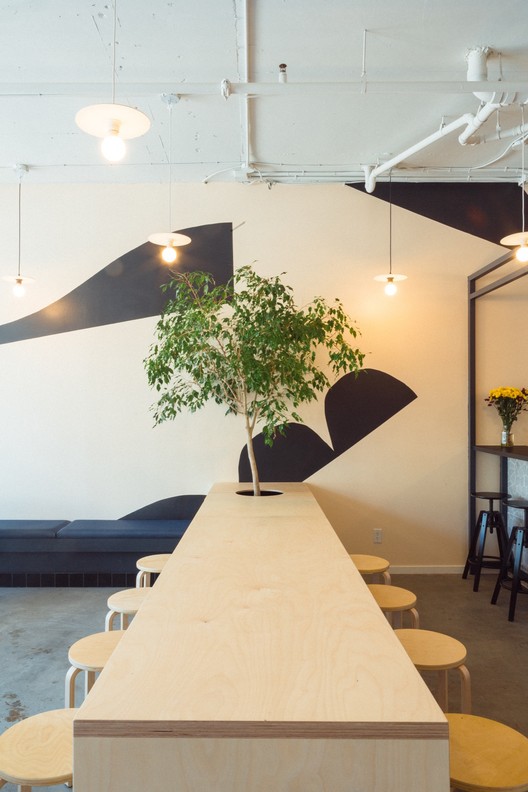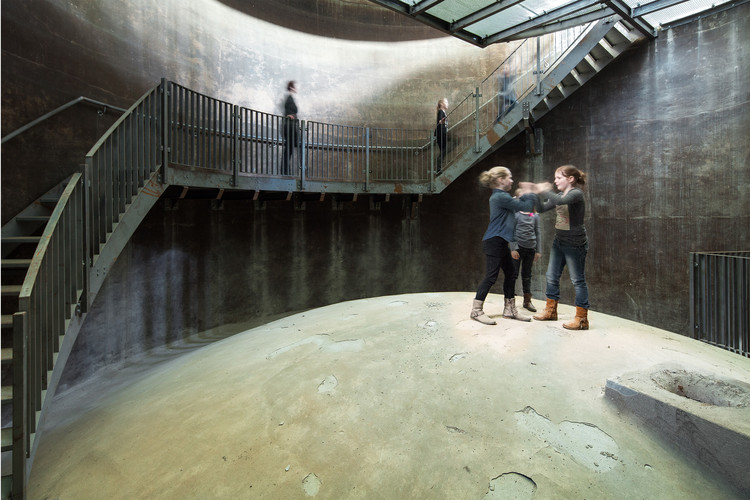History of Science Centre Hoehler + alSalmy
2018-11-26 00:00
架构师提供的文本描述。科学历史中心充当调解人,将过去的伊斯兰科学“黄金时代”与目前在阿曼哈尔班的德国技术大学(GUtech)的大学学习联系起来。这座建筑的目的是在艺术和科学与自然和几何学之间建立一种联系,同时象征着无限和神性。
Text description provided by the architects. The History of Science Centre acts as a mediator bringing past Islamic sciences of the "golden age" in relation to the current university studies at the German University of Technology (GUtech) in Halban, Oman. The building aims to create a link between art and science with nature and geometry whilst symbolizin
Text description provided by the architects. The History of Science Centre acts as a mediator bringing past Islamic sciences of the "golden age" in relation to the current university studies at the German University of Technology (GUtech) in Halban, Oman. The building aims to create a link between art and science with nature and geometry whilst symbolizin
© Capture Media
C.捕获媒体


为实现项目的成功设计,使用了许多创新技术。建筑分为两个部分:一个外部几何独立的混凝土外壳包围着内部建筑。
Numerous innovative techniques were used to deliver the successful design of the project. The building is divided into two sections; an external geometrical standalone concrete shell enveloping the inner building.
Numerous innovative techniques were used to deliver the successful design of the project. The building is divided into two sections; an external geometrical standalone concrete shell enveloping the inner building.
© Capture Media
C.捕获媒体


所选择的壳体结构几何图案来源于加拉维茵清真寺和大学(公元857),该清真寺被称为整个地中海地区的知识和科学中心,其几何形状的宽度随太阳的方向变化而变化;控制空间的温度和光线,同时增加结构的建筑意义。整个内部表面按照太阳和风向倾斜,以进一步协助温度控制单元。
The chosen geometric pattern of the shell structure was derived from the Qarawiyyin Mosque and University (AD 857) known as the centre of knowledge and science for the entire Mediterranean region. The width of the geometrical pattern changes according to the direction of the sun; controlling both the temperature and light of the space whilst adding to the architectural significance of the structure. The entire internal surface is inclined in accordance with the sun and wind direction to further assist with the temperature control element.
The chosen geometric pattern of the shell structure was derived from the Qarawiyyin Mosque and University (AD 857) known as the centre of knowledge and science for the entire Mediterranean region. The width of the geometrical pattern changes according to the direction of the sun; controlling both the temperature and light of the space whilst adding to the architectural significance of the structure. The entire internal surface is inclined in accordance with the sun and wind direction to further assist with the temperature control element.


建筑物的主要入口由有意放置的切割图案高度界定。在地面上,由立面保护和包裹的独立式箱提供1,200平方米的展览空间。该区域将用作参观展览的临时区域。这与传统的研究图书馆、咖啡店和儿童的玩耍区域一起忽视了在浅出生时的生活方式;使玛丽娜成为阿曼多产的航海史的贡品。使用传统建筑技术作为旧的阿曼船只的复制品,专门为该中心制作和建造了该中心。
The main entrance to the building is highly defined by the purposely placed cut pattern. On the ground floor, a free-standing box protected and wrapped by the facade provides 1,200sqm of exhibition space. The area will be used as a temporary area for visiting exhibitions. This, together with a heritage research library, a coffee shop and a children’s play area overlook a dhow placed in the shallow birth; made to resemble a marina as a tribute to Oman’s prolific seafaring history. The dhow was specially made and built for the Centre using traditional building techniques as a replica of old Omani vessels.
The main entrance to the building is highly defined by the purposely placed cut pattern. On the ground floor, a free-standing box protected and wrapped by the facade provides 1,200sqm of exhibition space. The area will be used as a temporary area for visiting exhibitions. This, together with a heritage research library, a coffee shop and a children’s play area overlook a dhow placed in the shallow birth; made to resemble a marina as a tribute to Oman’s prolific seafaring history. The dhow was specially made and built for the Centre using traditional building techniques as a replica of old Omani vessels.
© Gijo Paul George
c.Gijo Paul George


在大楼的中心,有两个环形楼梯,创建一个建筑之旅,从地球周围升起,包括一个活动的太阳表盘,它利用几何外壳中的一个特定的孔告诉时间。每一个2-比例的窗口模式都是从2016年7月21日太阳的位置所产生的每小时太阳黑子得来的。
At the center of the building are two endless staircases creating an architectural journey rising to the first floor comprising the main exhibition of artifacts from around the globe, including an active sundial that utilizes a specific hole in the geometrical shell to tell the time. Each 2-scaled window pattern is derived from the hourly sunspots, arising from the sun’s position on 21st July 2016.
At the center of the building are two endless staircases creating an architectural journey rising to the first floor comprising the main exhibition of artifacts from around the globe, including an active sundial that utilizes a specific hole in the geometrical shell to tell the time. Each 2-scaled window pattern is derived from the hourly sunspots, arising from the sun’s position on 21st July 2016.
© Capture Media
C.捕获媒体


展览廊包含一系列国际历史文物,显示从古希腊罗马时代早期到伊斯兰时期和现在社会发展应用科学。艺术馆分为三个部分:第一部分为渗透展览,展示各种数学、地质、导航、天体逻辑、光学和机械仪器、人工制品和交互式显示器。第二部分包含了科学史的科学图书馆。最后一节是为教育项目提供的,这些项目将与古科技大学的学术项目相联系。
The Exhibition Gallery contains a range of international historical artifacts displaying the development of applied science from the early age of classical Greek-Roman era, through to the Islamic period and into the present society. The gallery is divided into three sections; the first segment holds a permeant exhibition displaying a diverse range of Mathematical, Geological, Navigational, Astrological, Optical and Mechanical instruments, artefacts and interactive displays. The second section contains the Scientific Library of History of Science. The final section is for educational programs which will be linked to the academic programs at the GUtech university.
The Exhibition Gallery contains a range of international historical artifacts displaying the development of applied science from the early age of classical Greek-Roman era, through to the Islamic period and into the present society. The gallery is divided into three sections; the first segment holds a permeant exhibition displaying a diverse range of Mathematical, Geological, Navigational, Astrological, Optical and Mechanical instruments, artefacts and interactive displays. The second section contains the Scientific Library of History of Science. The final section is for educational programs which will be linked to the academic programs at the GUtech university.
© Gijo Paul George
c.Gijo Paul George


大学校园前倾斜的中央广场作为公共区域扩展到大楼的底层。中央广场是以几何图案的线条为基础形成的,这些线条延伸到形成一种带有绿色岛屿和水特征的地毯状效果。
The sloped central square in front of the university campus expands as a public area to the ground floor of the building. The central square is formed based on the lines of the geometrical pattern that extend to create a carpet-like effect with green islands and water features.
The sloped central square in front of the university campus expands as a public area to the ground floor of the building. The central square is formed based on the lines of the geometrical pattern that extend to create a carpet-like effect with green islands and water features.
© Osama Al Kharusi
(乌萨马·哈鲁西)


该项目与最初的设计没有什么不同,而是按照给定的规格建造的,完全是原组装模型的复制品。建筑工程在时间表和预算参数范围内完成,没有任何受伤报告,完全令人满意,超出了所有有关各方的预期。第一次展览将于2018年末向公众开放。
The project did not differ from the original design and has been constructed as per the given specifications as an exact replica of the original assembled model. The construction was finalized within schedule and budget parameters, with zero reported injuries and to full satisfaction and exceeded expectation from all involved parties. The first exhibition will be open to the public this late 2018.
The project did not differ from the original design and has been constructed as per the given specifications as an exact replica of the original assembled model. The construction was finalized within schedule and budget parameters, with zero reported injuries and to full satisfaction and exceeded expectation from all involved parties. The first exhibition will be open to the public this late 2018.
© Osama Al Kharusi
(乌萨马·哈鲁西)






























































































Architects Hoehler + alSalmy
Location Halban, Oman
Lead Architects Muhammad AlSalmy, Ernst Höhler, Christoph Fischer
Area 3600.0 m2
Project Year 2016
Photographs Capture Media, Nathan McCall, Osama Al Kharusi, Gijo Paul George
Category Science Center
























